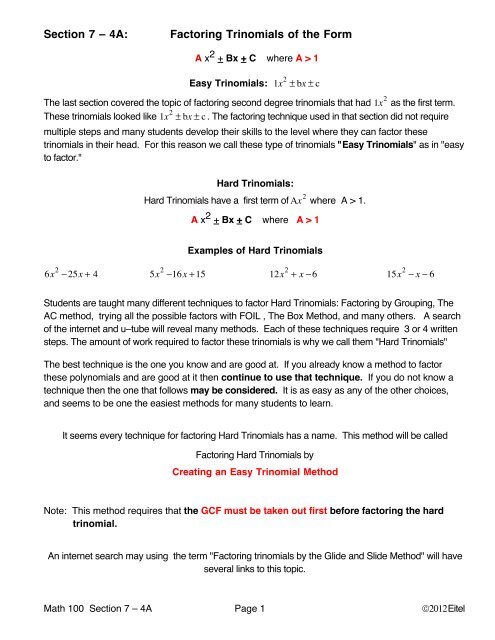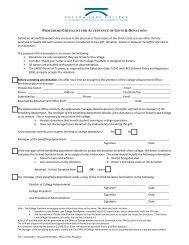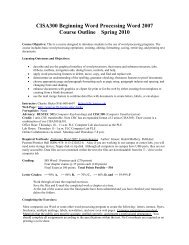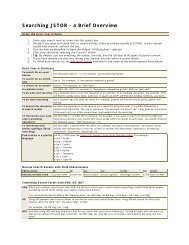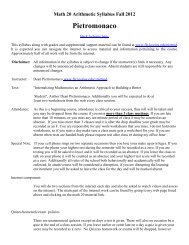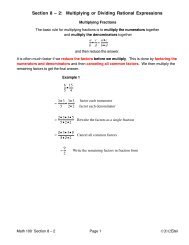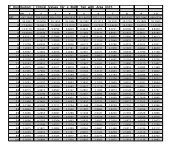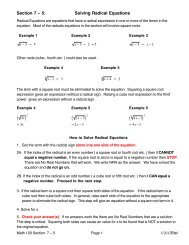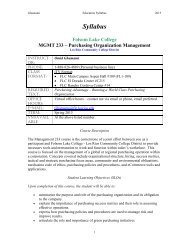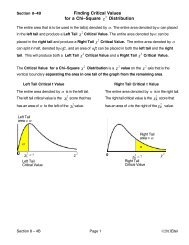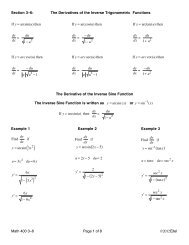Factoring Hard Trinomials by the Easy Trinomials Method Lecture
Factoring Hard Trinomials by the Easy Trinomials Method Lecture
Factoring Hard Trinomials by the Easy Trinomials Method Lecture
You also want an ePaper? Increase the reach of your titles
YUMPU automatically turns print PDFs into web optimized ePapers that Google loves.
Section 7 – 4A:<br />
<strong>Factoring</strong> <strong>Trinomials</strong> of <strong>the</strong> Form<br />
A x 2 + Bx + C where A > 1<br />
<strong>Easy</strong> <strong>Trinomials</strong>: 1x 2 ± bx ± c<br />
The last section covered <strong>the</strong> topic of factoring second degree trinomials that had 1x 2 as <strong>the</strong> first term.<br />
These trinomials looked like 1x 2 ± bx ± c . The factoring technique used in that section did not require<br />
multiple steps and many students develop <strong>the</strong>ir skills to <strong>the</strong> level where <strong>the</strong>y can factor <strong>the</strong>se<br />
trinomials in <strong>the</strong>ir head. For this reason we call <strong>the</strong>se type of trinomials "<strong>Easy</strong> <strong>Trinomials</strong>" as in "easy<br />
to factor."<br />
<strong>Hard</strong> <strong>Trinomials</strong>:<br />
<strong>Hard</strong> <strong>Trinomials</strong> have a first term of Ax 2 where A > 1.<br />
A x 2 + Bx + C where A > 1<br />
Examples of <strong>Hard</strong> <strong>Trinomials</strong><br />
6x 2 −25x + 4 5x 2 −16x +15 12x 2 + x −6 15x 2 − x − 6<br />
Students are taught many different techniques to factor <strong>Hard</strong> <strong>Trinomials</strong>: <strong>Factoring</strong> <strong>by</strong> Grouping, The<br />
AC method, trying all <strong>the</strong> possible factors with FOIL , The Box <strong>Method</strong>, and many o<strong>the</strong>rs. A search<br />
of <strong>the</strong> internet and u–tube will reveal many methods. Each of <strong>the</strong>se techniques require 3 or 4 written<br />
steps. The amount of work required to factor <strong>the</strong>se trinomials is why we call <strong>the</strong>m "<strong>Hard</strong> <strong>Trinomials</strong>"<br />
The best technique is <strong>the</strong> one you know and are good at. If you already know a method to factor<br />
<strong>the</strong>se polynomials and are good at it <strong>the</strong>n continue to use that technique. If you do not know a<br />
technique <strong>the</strong>n <strong>the</strong> one that follows may be considered. It is as easy as any of <strong>the</strong> o<strong>the</strong>r choices,<br />
and seems to be one <strong>the</strong> easiest methods for many students to learn.<br />
It seems every technique for factoring <strong>Hard</strong> <strong>Trinomials</strong> has a name. This method will be called<br />
<strong>Factoring</strong> <strong>Hard</strong> <strong>Trinomials</strong> <strong>by</strong><br />
Creating an <strong>Easy</strong> Trinomial <strong>Method</strong><br />
Note: This method requires that <strong>the</strong> GCF must be taken out first before factoring <strong>the</strong> hard<br />
trinomial.<br />
An internet search may using <strong>the</strong> term "<strong>Factoring</strong> trinomials <strong>by</strong> <strong>the</strong> Glide and Slide <strong>Method</strong>" will have<br />
several links to this topic.<br />
Math 100 Section 7 – 4A Page 1 ©2012 Eitel
Creating an <strong>Easy</strong> Trinomial <strong>Method</strong><br />
Example 1<br />
Factor: 3x 2 + 7x + 2<br />
Step 1: The GCF must be taken out first (if <strong>the</strong>re is one) before factoring <strong>the</strong> hard trinomial.<br />
Step 2: Create an <strong>Easy</strong> Trinomial <strong>by</strong> moving <strong>the</strong> coefficient of <strong>the</strong> 3 x 2 term<br />
to <strong>the</strong> end of <strong>the</strong> trinomial and multiplying <strong>the</strong> 3 and <strong>the</strong> 2<br />
3x 2 + 7x + 2 •3<br />
to get <strong>the</strong> easy trinomial<br />
x 2 + 7x + 6<br />
Step 3: Factor <strong>the</strong> easy trinomial <strong>by</strong> finding <strong>the</strong> 2 numbers that<br />
multiply to + 6 and add to + 7<br />
+ 6 and + 1<br />
( x + 6 ) ( x + 1)<br />
Step 4: In Step 1 you multiplied <strong>the</strong> constant 2 <strong>by</strong> <strong>the</strong> 3 that was <strong>the</strong> coefficient of <strong>the</strong> 3 x 2 term.<br />
Now divide BOTH of <strong>the</strong> constants in (x + 6 )( x + 1) <strong>by</strong> 3<br />
⎛<br />
x + 6 ⎞<br />
⎜<br />
⎝ 3⎠<br />
⎟ ⎛<br />
x + 1 ⎞<br />
⎜<br />
⎝ 3 ⎟<br />
⎠<br />
reduce each fraction<br />
⎛ ⎞<br />
x + 2 ⎜ ⎟<br />
⎝ ⎠<br />
( ) x + 1 3<br />
Step 5: "glide" <strong>the</strong> denominator of each fraction (if <strong>the</strong>re is one) to <strong>the</strong> front of <strong>the</strong> x term<br />
( x + 2 ) ⎛<br />
⎜ 3 x + 1 ⎝ 3<br />
⎞<br />
⎟<br />
⎠<br />
( x + 2 ) ( 3x +1 )<br />
Factor: 3x 2 + 7x + 2<br />
(x + 2) (3x +1)<br />
Math 100 Section 7 – 4A Page 2 ©2012 Eitel
Creating an <strong>Easy</strong> Trinomial <strong>Method</strong><br />
Example 2<br />
Factor: 2x 2 −9x +10<br />
Step 1: The GCF must be taken out first (if <strong>the</strong>re is one) before factoring <strong>the</strong> hard trinomial.<br />
Step 2: Create an <strong>Easy</strong> Trinomial <strong>by</strong> moving <strong>the</strong> coefficient of <strong>the</strong> 2 x 2 term<br />
to <strong>the</strong> end of <strong>the</strong> trinomial and multiplying <strong>the</strong> 2 and <strong>the</strong> 10<br />
2x 2 −9x +10 •2<br />
to get <strong>the</strong> easy trinomial<br />
x 2 − 9x + 20<br />
Step 3: Factor <strong>the</strong> easy trinomial <strong>by</strong> finding <strong>the</strong> 2 numbers that<br />
multiply to + 20 and add to –9<br />
– 5 and – 4<br />
( x – 5) ( x – 4)<br />
Step 4: In step 1 you multiplied <strong>the</strong> constant 10 <strong>by</strong> <strong>the</strong> 2 that was <strong>the</strong> coefficient of <strong>the</strong> 2 x 2 term.<br />
Now divide BOTH of <strong>the</strong> constants in (x – 5 )( x – 4) <strong>by</strong> 2<br />
⎛<br />
x − 5 ⎞<br />
⎜<br />
⎝ 2⎠<br />
⎟ ⎛<br />
x − 4 ⎞<br />
⎜<br />
⎝ 2 ⎟<br />
⎠<br />
reduce each fraction<br />
⎛<br />
x − 5 ⎞<br />
⎜ ⎟ x − 2<br />
⎝ 2⎠<br />
( )<br />
Step 5: "glide" <strong>the</strong> denominator of each fraction (if <strong>the</strong>re is one) to <strong>the</strong> front of <strong>the</strong> x term<br />
⎛<br />
⎜<br />
⎝<br />
2 x − 5 2<br />
⎞<br />
⎟ ( x − 2)<br />
⎠<br />
( 2x −5 ) ( x − 2)<br />
Factor: 2x 2 −9x +10<br />
(2x − 5) (x − 2)<br />
Math 100 Section 7 – 4A Page 3 ©2012 Eitel
Creating an <strong>Easy</strong> Trinomial <strong>Method</strong><br />
Example 3<br />
Factor: 6x 2 − x −1<br />
Step 1: The GCF must be taken out first (if <strong>the</strong>re is one) before factoring <strong>the</strong> hard trinomial.<br />
Step 2: Create an <strong>Easy</strong> Trinomial <strong>by</strong> moving <strong>the</strong> coefficient of <strong>the</strong> 6 x 2 term<br />
to <strong>the</strong> end of <strong>the</strong> trinomial and multiplying <strong>the</strong> 6 and <strong>the</strong> –1<br />
6x 2 − x −1 • 6<br />
to get <strong>the</strong> easy trinomial<br />
x 2 − x −6<br />
Step 3: Factor <strong>the</strong> easy trinomial <strong>by</strong> finding <strong>the</strong> 2 numbers that<br />
multiply to – 6 and subtract to – 1<br />
– 3 and + 2<br />
( x – 3 ) ( x + 2 )<br />
Step 4: In step 1 you multiplied <strong>the</strong> constant –1 <strong>by</strong> <strong>the</strong> 6 that was in front of <strong>the</strong> x 2 term.<br />
Now divide BOTH of <strong>the</strong> constants in ( x – 3 ) ( x + 2 ) <strong>by</strong> 6<br />
⎛<br />
⎜<br />
⎝<br />
x − 3 6<br />
⎞<br />
⎠<br />
⎟ ⎛<br />
⎜ x + 2 ⎝ 6<br />
⎞<br />
⎟<br />
⎠<br />
reduce each fraction<br />
⎛<br />
x − 1 ⎞<br />
⎜<br />
⎝ 2⎠<br />
⎟ ⎛<br />
x + 1 ⎞<br />
⎜<br />
⎝ 3 ⎟<br />
⎠<br />
Step 5: "glide" <strong>the</strong> denominator of each fraction (if <strong>the</strong>re is one) to <strong>the</strong> front of <strong>the</strong> x term<br />
⎛<br />
x − 1 ⎞<br />
⎜<br />
⎝ 2⎠<br />
⎟ ⎛<br />
x + 1 ⎞<br />
2 ⎜ 3<br />
⎝ 3 ⎟<br />
⎠<br />
( 2x −1 ) ( 3x +1)<br />
Factor: 6x 2 − x − 6<br />
(2x −1) (3x +1)<br />
Math 100 Section 7 – 4A Page 4 ©2012 Eitel
Creating an <strong>Easy</strong> Trinomial <strong>Method</strong><br />
Example 4<br />
Factor: 16x 2 −8x +1<br />
Step 1: The GCF must be taken out first (if <strong>the</strong>re is one) before factoring <strong>the</strong> hard trinomial.<br />
Step 2: Create an <strong>Easy</strong> Trinomial <strong>by</strong> moving <strong>the</strong> coefficient of <strong>the</strong> 16 x 2 term<br />
to <strong>the</strong> end of <strong>the</strong> trinomial and multiplying <strong>the</strong> 16 and <strong>the</strong> –1<br />
16x 2 −8x −1 •16<br />
to get <strong>the</strong> easy trinomial<br />
x 2 − 8x −16<br />
Step 3: Factor <strong>the</strong> easy trinomial <strong>by</strong> finding <strong>the</strong> 2 numbers that<br />
multiply to –16 and subtract to –8<br />
– 4 and – 4<br />
( x – 4) ( x – 4 )<br />
Step 4: In step 1 you multiplied <strong>the</strong> constant –1 <strong>by</strong> <strong>the</strong> 16 that was in front of <strong>the</strong> x 2 term.<br />
Now divide BOTH of <strong>the</strong> constants in ( x – 4) ( x – 4 ) <strong>by</strong> 16<br />
⎛<br />
⎜<br />
⎝<br />
x − 4 16<br />
⎞ ⎛<br />
⎟ ⎜ x − 4<br />
⎠ ⎝ 16<br />
⎞<br />
⎟<br />
⎠<br />
reduce each fraction<br />
⎛<br />
x − 1 ⎞<br />
⎜<br />
⎝ 4 ⎠<br />
⎟ ⎛<br />
x − 1 ⎞<br />
⎜<br />
⎝ 4 ⎟<br />
⎠<br />
Step 5: "glide" <strong>the</strong> denominator of each fraction (if <strong>the</strong>re is one) in front of <strong>the</strong> x term<br />
⎛<br />
x − 1 ⎞<br />
⎜<br />
⎝ 4 ⎠<br />
⎟ ⎛<br />
x − 1 ⎞<br />
4 ⎜ 4<br />
⎝ 4 ⎟<br />
⎠<br />
( 4 x −1 ) ( 4x −1)<br />
Factor: 16x 2 −8x +1<br />
(4x −1) (4x −1)<br />
Math 100 Section 7 – 4A Page 5 ©2012 Eitel
Creating an <strong>Easy</strong> Trinomial <strong>Method</strong><br />
Example 5<br />
Factor: 4x 2 + 23x − 6<br />
Step 1: The GCF must be taken out first (if <strong>the</strong>re is one) before factoring <strong>the</strong> hard trinomial.<br />
Step 2: Create an <strong>Easy</strong> Trinomial <strong>by</strong> moving <strong>the</strong> coefficient of <strong>the</strong> 4 x 2 term<br />
to <strong>the</strong> end of <strong>the</strong> trinomial and multiplying <strong>the</strong> 4 and <strong>the</strong> – 6<br />
4x 2 + 23x − 6 •4<br />
to get <strong>the</strong> easy trinomial<br />
x 2 + 23x − 24<br />
Step 3: Factor <strong>the</strong> easy trinomial <strong>by</strong> finding <strong>the</strong> 2 numbers that<br />
multiply to – 24 and subtract to + 23<br />
– 24 and + 1<br />
( x + 24 ) ( x – 1 )<br />
Step 4: In step 1 you multiplied <strong>the</strong> constant –6 <strong>by</strong> <strong>the</strong> 4 that was in front of <strong>the</strong> x 2 term.<br />
Now divide BOTH of <strong>the</strong> constants in ( x + 24 ) ( x – 1 ) <strong>by</strong> 4<br />
⎛<br />
⎜<br />
⎝<br />
x + 24 4<br />
⎞<br />
⎠<br />
⎟ ⎛<br />
⎜ x − 1 ⎝ 4<br />
⎞<br />
⎟<br />
⎠<br />
reduce each fraction<br />
( x + 6 ) ⎛<br />
x − 1 ⎞<br />
⎜<br />
⎝ 4 ⎟<br />
⎠<br />
Step 5: "glide" <strong>the</strong> denominator of each fraction (if <strong>the</strong>re is one) in front of <strong>the</strong> x term<br />
( x + 6 ) ⎛<br />
x − 1 ⎞<br />
⎜ 4<br />
⎝ 4 ⎟<br />
⎠<br />
( x + 6) ( 4 x −1)<br />
Math 100 Section 7 – 4A Page 6 ©2012 Eitel
The GCF must be taken out first before factoring <strong>the</strong> hard trinomial<br />
To factor any polynomial completely you should factor <strong>the</strong> GCF out FIRST if <strong>the</strong> polynomial has a<br />
GCF. If <strong>the</strong> polynomial remaining inside <strong>the</strong> paren<strong>the</strong>ses is a trinomial that can be factored <strong>the</strong>n <strong>the</strong><br />
complete factored answer is <strong>the</strong> product of <strong>the</strong> GCF and <strong>the</strong> factored trinomial.<br />
Example 6<br />
Factor: 6x 2 + 26x + 8<br />
The GCF must be taken out first (if <strong>the</strong>re is one) before factoring <strong>the</strong> hard trinomial.<br />
Factor: 6x 2 + 26x + 8<br />
Factor out <strong>the</strong> GCF of 2<br />
( )<br />
2 3x 2 +13x + 4<br />
now factor <strong>the</strong> hard trinominal<br />
3x 2 +13x + 4<br />
Factor: 3x 2 +13x + 4<br />
Multiply <strong>the</strong> 3 <strong>by</strong> <strong>the</strong> 4<br />
to get <strong>the</strong> easy trinomal<br />
x 2 +13x +12<br />
factor<br />
( x +12) x +1<br />
( )<br />
Divide both constants <strong>by</strong> 3<br />
⎛<br />
x + 12 ⎝ 3<br />
⎞ ⎛<br />
x + 1 ⎞<br />
⎠ ⎝ 3⎠<br />
reduce <strong>the</strong> 12 3<br />
in <strong>the</strong> first factor<br />
and glide <strong>the</strong> 3 in front of <strong>the</strong> x in <strong>the</strong> second factor<br />
( x + 4) ( 3x +1)<br />
be sure to include <strong>the</strong> GCF you factored out<br />
in Step 1 in <strong>the</strong> final answer<br />
Answer: 2 ( x + 4) ( 3x +1)<br />
Math 100 Section 7 – 4A Page 7 ©2012 Eitel
Some <strong>Trinomials</strong> DO NOt Factor (DNF)<br />
Many trinomials cannot be factored.<br />
We write DOES NOt Factor or Prime or DNF if that is <strong>the</strong> case.<br />
Example 7<br />
Factor: 3x 2 + 2x + 4<br />
Step 2: Create an <strong>Easy</strong> Trinomial <strong>by</strong> moving <strong>the</strong> coefficient of <strong>the</strong> 3 x 2 term<br />
to <strong>the</strong> end of <strong>the</strong> trinomial and multiplying <strong>the</strong> 3 and <strong>the</strong> + 4<br />
3x 2 + 2x + 4 • 3<br />
to get <strong>the</strong> easy trinomial<br />
x 2 + 2x +12<br />
Step 3: Factor <strong>the</strong> easy trinomial <strong>by</strong> finding <strong>the</strong> 2 numbers that<br />
multiply to 12 and add to + 2<br />
<strong>the</strong>re are no numbers that work<br />
so <strong>the</strong> trinomial DOES NOT FACTOR<br />
We can also write DNF or Prime<br />
Math 100 Section 7 – 4A Page 8 ©2012 Eitel


